Bike fit and phisiotherapy#
After resting for a while and fix the cleats on my shoes again, I’ve done a couple of rides in the synapse, 109 km, +1332 m, 4 hours in total, without having any pain at all. I also did a 1 hour ride on the trainer, 39km +146 m in Zwift.
The knee definetely feels better, which is a relieve, but I still wanted to get to the root of it (if possible) and I’d really like to have some medical oppinion on the status of the knee.
And today, I had both things sorted out.
Last week, during a visit to my local bike shop (MyBike), I explained them what happened with my knee and my doubts about the positioning of my shoe cleats. They also pointed to the relation of pain and cleat position and they suggested me to give a call to a friend of them, Anibal Belassi, who is a cyclists trainer with lots of experience. He has a studio where I could get some help and even a complete bike-fit service.
I gave him a call last week, explained a bit the reason of my call and got an appointment for today. The idea was to talk a bit, look into my shoe cleats and maybe do the bike fit.
Remember I wrote in my previous entry (worried about injuries) that I had an appointment for the 30th of May with a phisiotherapist? Well, I got a call from that clinic yesterday. They had a slot available today.
So I had a busy morning today. First I took my daughters to school. Then I came back home and picked up the synapse, clothes, cycling shoes (both summer and winter) and packed everything in the car. I drove to one of those car wash stations to wash the synapse (which was completely dirty after a rainy ride yesterday) and then I headed to Anibal’s studio.
I arrived there at 10:00, our scheduled meeting time. I introduced myself and explained him my problem. He listened carefully and patiently and then he told me about his bike fitting and biometric testing procedures. I liked what I heard and saw, but I told him about my big concern regarding doing big changes in the bike fit in the middle of the season.
Finally, we agreed on doing the full bike fit but step by step. We were going to do all the measurements, both on myself and the bike, then move to check sizes and positions of saddle, handlebars, stem, etc and see if there were any adjustments needed to do. Finally, decide IF we should do them and what would that mean.
First he measured me, then he measured the bike and, after that, he put some tiny yellow dot stickers on my feet, leg, hip, etc. After measurements, I got on the bike and we checked my feet position to see if my shoe cleats were correctly set. Interestingly, they were “almost right” after my latest adjustments last week, we just had to do one minor adjustment on the right shoe cleat (my foot was a bit too close to the crank arm).
With the cleats adjusted, he did a few more measures with me sitting on the bike, and finally I started to push the pedals.
I did pedal for a while, with him watching closely, and then we did record a few videos while I was pedaling.
Long story short… My beloved synapse is like a glove for me. All fits perfectly, from frame size to stem length, crack arms length, handlebar width, all of it.
But (there had to be a “but”) he noticed something with the way I pushed the pedals. Not something serious, but a place where we had room for improvement.
Let’s see a capture made while I was pedaling, with the bike as it was when I went to visit Anibal:
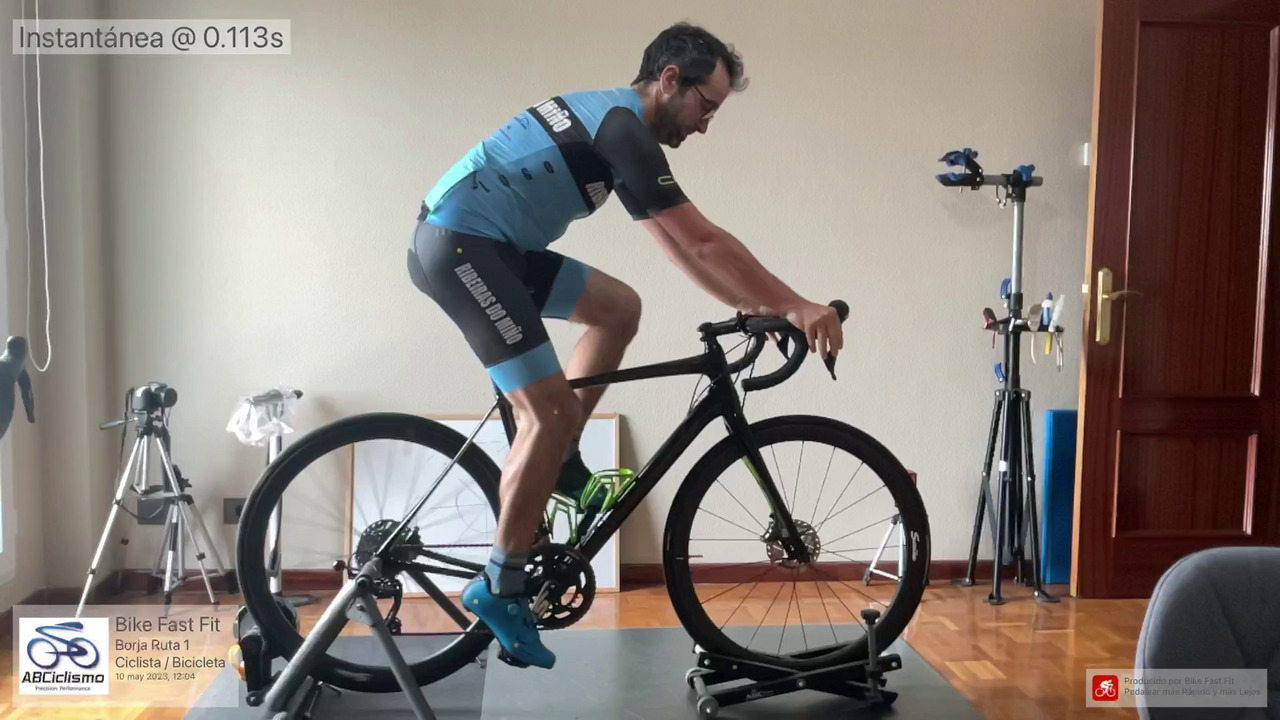
Now look at my right foot, specifically at the angle of my heel in relation with the floor. Apparently, that angle was too high/wide, which means I’ve been pedaling like walking on tip toes, which means I don’t transfer full power to the pedals when pushing them.
So, nothing serious that could cause any injuries, but something I could improve to be a better cyclist. Nice!
Based on that little discovery, plus all the measurements we made, Anibal suggested to move my saddle a tiny bit forward and then lower its height another tiny bit. Then he told me some tips on how to improve the way I push the pedals.
We did those small adjustments on the saddle and we repeated the video recording, with me trying to follow his advice to improve my pedaling.
The software he was using for recording the videos has some capabilities for taking measurements too, which helps comparing my position on the bike before and after the adjustments:
Before the adjustments:
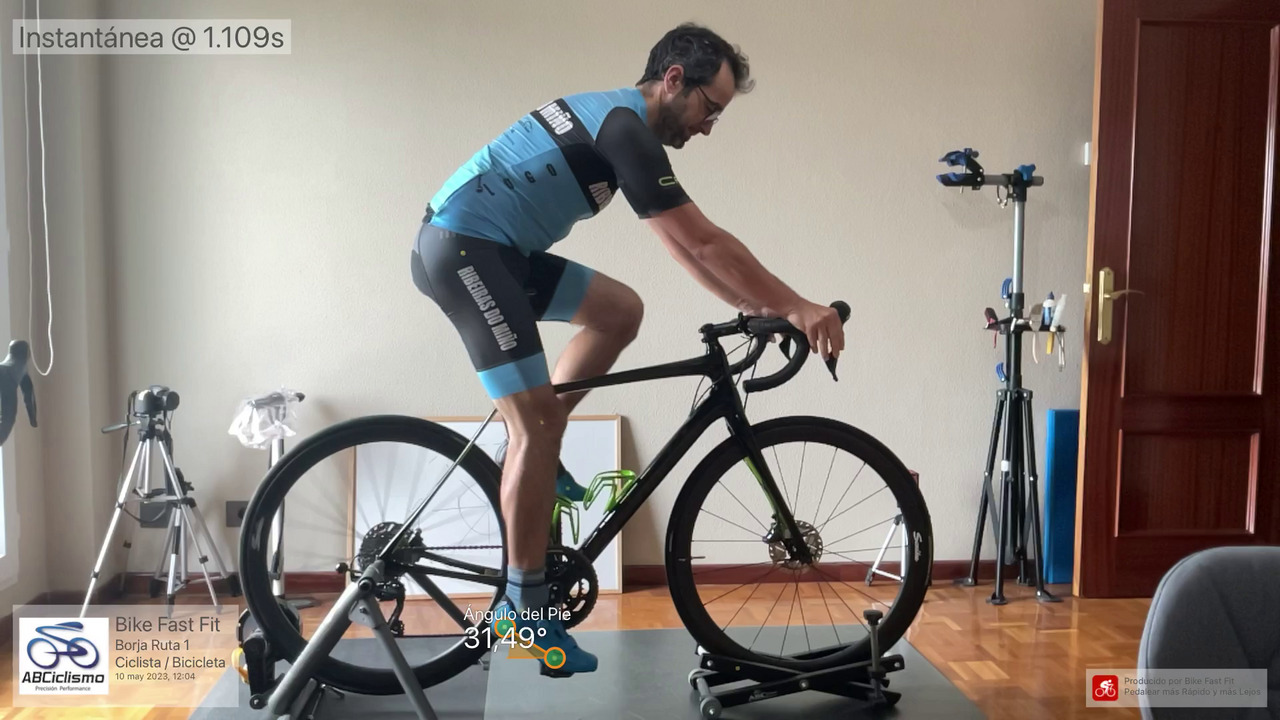
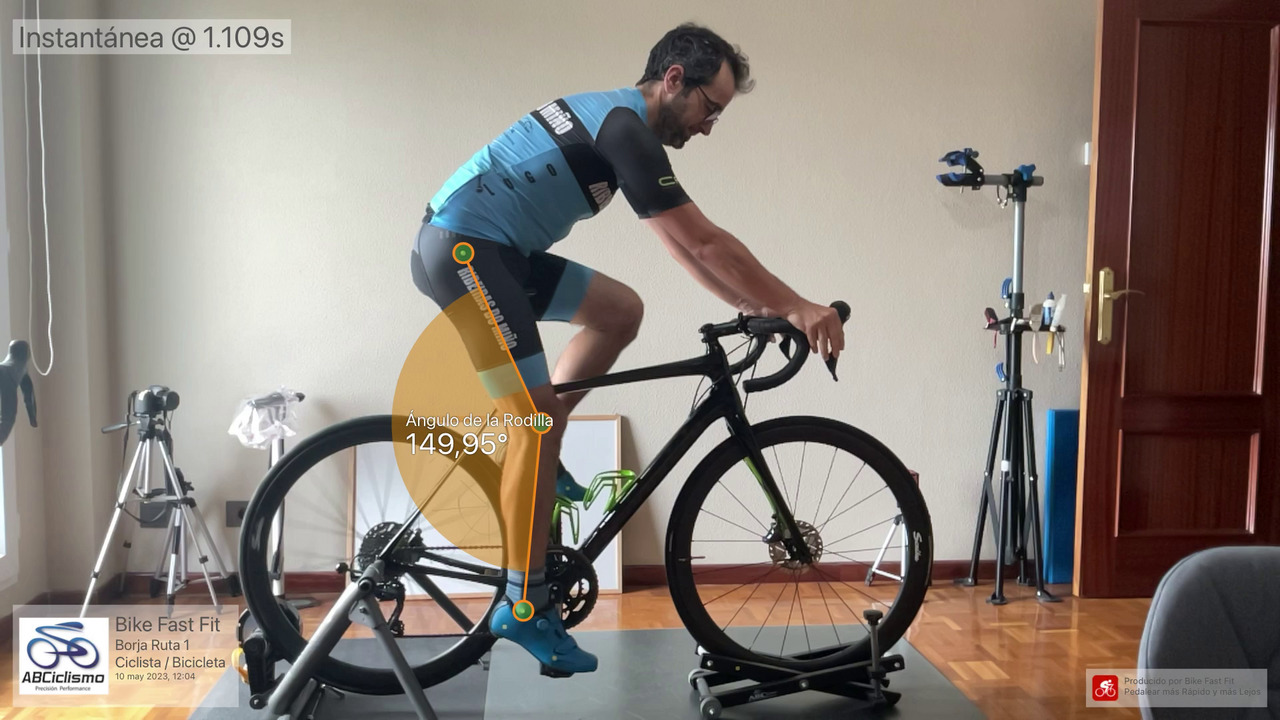
After the adjustments:
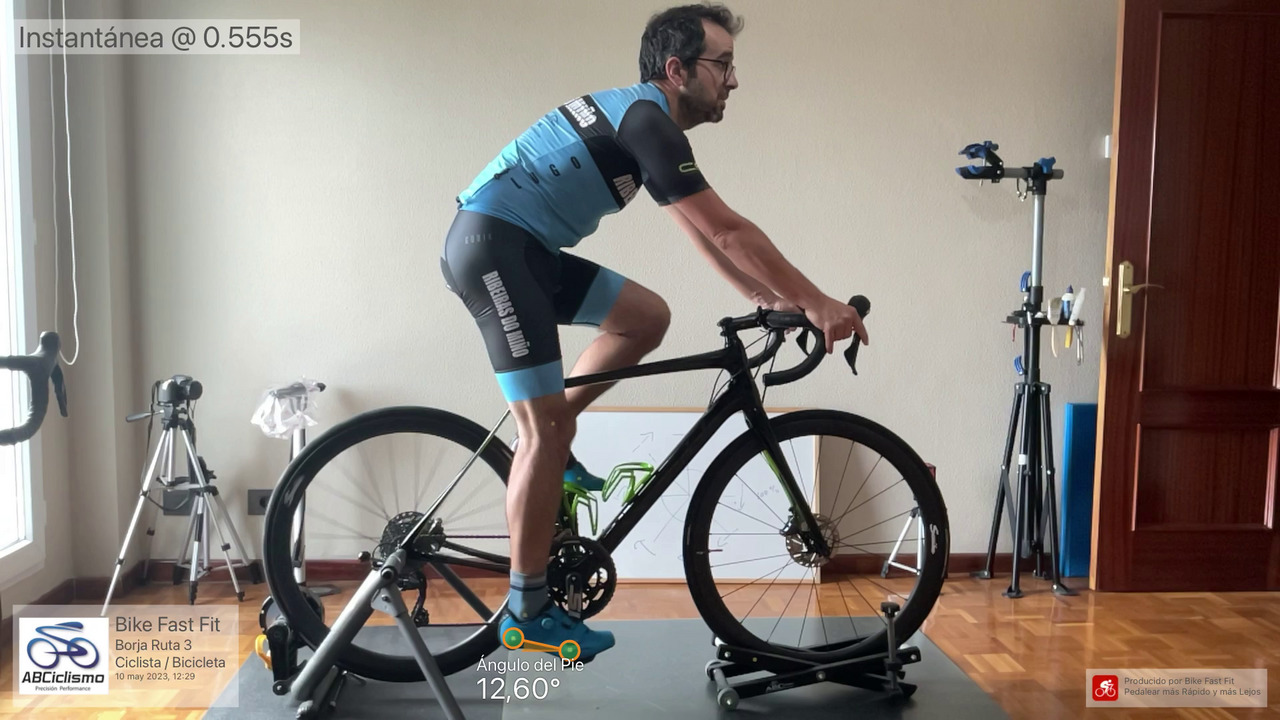
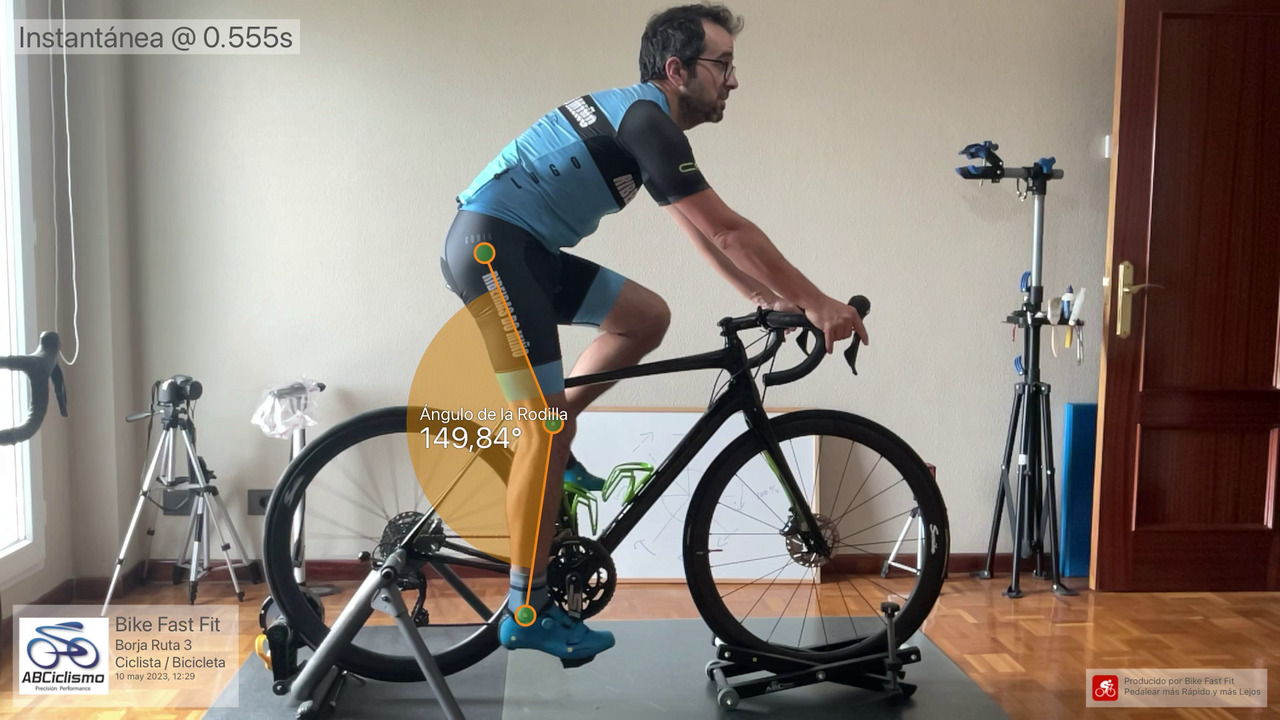
Looking at the numbers, it seems 31.49 degrees is way too much for that foot-floor angle (based on whatever scientific data they use as a base). Looking at the position… it definetely looks I was indeed pedaling like walking on tip toes.
I did pedal for a while on that trainer, and everything felt ok. I guess I’ll have to wait to do some longer rides to see if there is any significant difference (good or bad) caused by these adjustments.
Around 12:40 we stopped, with just a few things left to do, because I had the appointment at the phisiotherapy clinic at 13:00. I packed up my things and then booked an appointment to come back next week and finish things up.
And off I went, to the clinic. There I met Erik, tall muscled guy, who was going to take a look at my knee. I told him about the kind of cycling I do, long distances, brevets, etc and then I went right into describing the past month of April with those 3 strong brevet weekends, the shoe cleats issue and finally, the pain on my knee.
Based on the info I gave him, and the experience treating other cyclists, he also suspected the cleats could be the root of the problem, but we did an ultrasound scan on both knees to check how things were in there.
In the scan we saw there was a bit of liquid in both knees, but apart from that, all seemed fine. Back to “what happened here, doctor?”, Erik was really nice and took some time to explain his theory. The bad position in the cleats made me pedal in the wrong way for those long efforts, which caused one of the muscles connecting hip and leg to work in a way that made one tendon (called cintilla, in spanish) to suffer/rub/whatever. When that friction and extra work for the tendon was too much, pain appeared and then the body released the liquid in the knee area to compensate and prevent some more damage. (I just hope I’ve explained it with the proper words here).
Now, “should I rest longer, doctor?” (specially considering the next 400 and 600 in my calendar).
The answer was that the knee should be ok, specially I have fixed the shoe cleats problem. Then, Erik suggested to do a treatment to speed up the recovery on the tendon + the removal of that liquid.
Electrolisis Percutánea Intratisular is the name in spanish for that treatment (Percutaneous Electrolysis Therapy). Basically they use a needle to send galvanic micro-currents through you, focused on the area where you have a damaged tendon. Theoretically, this helps rebuilding/fixing tendon tissue, speeding up things.
No side effects and no problems about doing the Brevet this weekend… so I said yes and we did the treatment.
Needle went in without much problem, then we did 3 rounds of micro-currents, 8 seconds per round. The first one was barely noticeable, the second round was “interesting” and the third round… ouch, felt almost like the pain I had on the bike.
After the treatment, Erik gave me another treatment applying heat on both knees and then a full massage on the upper muscles of both legs. Man, that massage was a lot more painful than the micro-currents!
Before leaving, we discussed again the plans for this month. Erik was confident that the knee won’t cause trouble, but he suggested to bring some painkillers with me “just in case”. We decided to book a couple more appointments for the next weeks, he recommended to do another 2 sessions of the EPI treatment, plus he said it would be nice to keep an eye on my legs for some time.
So, I guess I did everything I could to handle this knee problem. I found what seemed to be the root of it, we fixed it, and then I double checked that everything was ok with my knees.
Let’s see how things will go this weekend, in the second 400 Brevet of the season.